Sarah L. Johnson's Blog, page 134
January 5, 2012
Book review: Curiosity, by Joan Thomas
 It's a current trend for historical fiction writers to re-examine neglected historical women and bring them back into the limelight. That said, one could hardly choose a better subject than Mary Anning, a carpenter's daughter from the village of Lyme Regis in seaside Dorset, whose unearthing of and knowledge about fossils led to some of the greatest paleontological discoveries of her time.
It's a current trend for historical fiction writers to re-examine neglected historical women and bring them back into the limelight. That said, one could hardly choose a better subject than Mary Anning, a carpenter's daughter from the village of Lyme Regis in seaside Dorset, whose unearthing of and knowledge about fossils led to some of the greatest paleontological discoveries of her time. The title of Joan Thomas's Curiosity refers to the "snakestones" (see the gorgeous cover) and other curios that Mary finds and sells to wealthy visitors who arrive on the coach from Bath, as well as to the quickness of mind Mary displays throughout the novel.
The term "curiosity" could also apply to Mary herself. A woman who "would never truly be appreciated in a drawing room" due to her country ways and quaint accent, she grows from a bright, inquisitive child to an independent spinster who carves her own path in a world where female contributions to science are discounted.
For readers used to tales of courtship, fancy dresses, and elegant repartee in Regency England, Curiosity will present a refreshingly different side to the era. While the Napoleonic Wars rage elsewhere, practical, constant, and confident Mary pursues her passion with determination, despite discouragement from others and a family life plagued by malnutrition and misfortune. Her father dies relatively young, leaving enormous debts, and out of ten children, only she and a brother will survive to adulthood. She sells fossils to earn enough money to live on, but it's often not enough.
Her story is interleaved with that of Henry De la Beche, a man who in his own way is as much an oddity as she. The son of a Jamaica plantation owner, he is expelled from military college following a prank and discovers a scientific bent while examining the bones of birds caught in his chimney.
While staying with his unaffectionate mother and her new husband at Lyme Regis, he encounters Mary and thinks her a most unusual young woman, one of the only people with whom he's free to be himself. Little is known of Mary's private life; while Henry's support of Mary's work is recorded, their gradual romance as described here is an imaginative re-creation of what might have been.
Both are trapped by the restrictions of their day: Henry by an unwelcome engagement to a society-minded girl, and Mary by her poverty and low place in a world that sees her interests as unnatural, and her fossils as possible manifestations of "the devil's work." Early 19th-century Britain sits at the cusp of scientific change, an era described in lucid and graceful language; no previous knowledge of paleontology is required.
At this time, with Darwin's Origin of Species some 40 years in the future, the ichthyosaur 12-year-old Mary so carefully excavates from limestone causes a flurry of questions to emerge. Did it perish in the Great Flood? Was coastal Dorset once a sea-bed, long ago? What is the meaning of a "day" in the Bible, if the specimens Mary finds prove to be much older than the accepted time of Creation?
One of Thomas's greatest strengths is her ability to depict an entire realm of scientific debate and vigor through the seemingly limited viewpoints of Mary and Henry. Although her male peers in distant London take credit for her work, the novel rightly places Mary and Lyme Regis at the center of the activity. From the beautiful descriptions of the region – in which the area's beaches and cliffs are layered with the remains of ancient creatures – to the characters' dialogue, reactions, and social values, everything feels on point.
This is an invigorating and quietly compelling book, and while there are no dull or dry moments, some sections seem drawn out to a great degree. The depth of detail adds, though, to an extensive picture of the characters' lives and times. While Mary's story is sometimes a sad one, readers should leave it feeling great admiration for her accomplishments, as well as appreciation for how Thomas has fictionalized her life with such care and poignancy.
Curiosity was published in 2011 by Emblem, an imprint of McClelland & Stewart, in trade paperback at $21.00 in Canada and the US and at £14.99 in the UK.
Published on January 05, 2012 11:25
January 4, 2012
Mercury's Rise giveaway winner
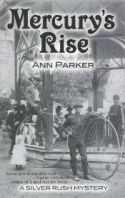 It was great to see so many entries for the giveaway copy of Ann Parker's Mercury's Rise! Thanks to all who participated.
It was great to see so many entries for the giveaway copy of Ann Parker's Mercury's Rise! Thanks to all who participated. Following a random number drawing courtesy of Random.org, the signed book will be going to Caroline B.
Congratulations, Caroline, and I'll be dropping you an email to get your mailing address. I hope you'll enjoy reading it as much as I did. Also included is a bookmark giving details on the other three books in the Silver Rush mystery series.
Published on January 04, 2012 06:07
December 31, 2011
A New England trip - with books, of course
I've been finding it difficult to get back to blogging after nearly two weeks without posting anything. This end-of-year post contains some history, some books, and a good many pictures. (My husband Mark was the photographer.)
Both our semesters having wrapped up, Mark and I took off for New England on December 22nd for a short trip to visit family and see some literary and historical venues. We made our first photo stop at my favorite used bookstore, the Niantic Book Barn along the Connecticut coastline.
They have three stores, two annexes in downtown Niantic and the main store about a mile west of town. The latter is comprised of a number of barns and outbuildings full of reasonably priced books.

If you're anywhere in the area, make your way to this store, pronto, and bring your wish lists because they have about 500,000 books in stock at any given time. A good deal of the fiction is either outdoors under awnings or in unheated (or unevenly heated) barns, so I wore my winter coat and gloves. Definitely worth it, though.
They must have some locals who trade in recent purchases or review copies regularly, because this is what I ended up with, below. (The top two are actually UK sagas about WWII given to me by my father, but they made it in the picture too, along with my photogenic orange kitty, Oliver. My 4-ft TBR pile(s) at far left.)

Nearly all of these are historical mysteries with the exception of Mackenzie Ford's Gifts of War, which is a romance of sorts set during WWI. Coincidentally I found the newly published sequel to Miss Dimple Disappears, which I reviewed not long ago. Mignon Ballard's Miss Dimple Rallies to the Cause is another WWII cozy mystery set in Georgia.
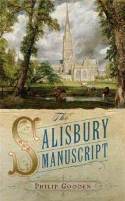 I finished Philip Gooden's The Salisbury Manuscript on the plane trip home. First in a series, it's a historical mystery set in the cathedral town of Salisbury in the 1870s. A young London-based lawyer, Tom Ansell, is sent to retrieve the unpublished memoir written by a local clergyman's late father and spirit it away for safekeeping. Seems the contents are rather racy and potentially embarrassing.
I finished Philip Gooden's The Salisbury Manuscript on the plane trip home. First in a series, it's a historical mystery set in the cathedral town of Salisbury in the 1870s. A young London-based lawyer, Tom Ansell, is sent to retrieve the unpublished memoir written by a local clergyman's late father and spirit it away for safekeeping. Seems the contents are rather racy and potentially embarrassing.
To Tom's unpleasant surprise, he finds himself a suspect in the canon's murder, and that mystery intertwines with archaeological discoveries from the region and odd goings-on among the townspeople. Although he's somewhat colorless in contrast to the eccentrics he meets, his sarcastic sense of humor is visible to those who read carefully, and his lively girlfriend, a would-be sensation novelist on the lookout for new material, keeps the amusement level high. It's a good choice for those who enjoy mysteries of the traditional British sort, and I do.
After more family visits, it was off to Boston's North Shore, where we stopped in Salem for two nights. This is one of the best examples of a historic New England town common I've seen.

This enormous park sits in the center of the city, and a number of houses and stores face it from all directions. Lots of pastels in alternating hues. I bet you need special permission to paint your house a new color here.
Next we have a statue of Roger Conant, Salem's founder (and my 10th great-grandfather). He stands across from Salem Common, looking dour and Puritan-like in his cloak.
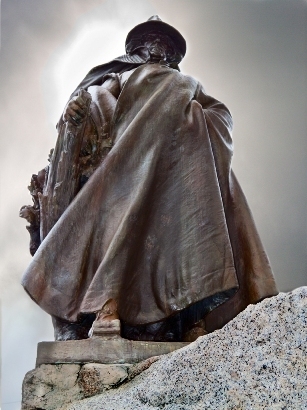
Because of Conant's proximity to the building below, many tourists believe he had something to do with the witch trials, but he died over a decade before that.

Ah, the Salem Witch Museum. It was 40 degrees the day we spent in Salem, which meant we didn't see many tourists on the streets even though the hotel was busy. Later we found out why. They were all at this prime attraction at the same time we were. We should have read the Yelp reviews beforehand, because the presentation we saw was pretty hokey. Mood lighting, life-size dioramas, and an over-the-top (but well-researched) soundtrack dramatize the events of the Salem witch trials. Kids might like it, but we didn't think it was worth $9 apiece.
Next was a historic house I wish we'd taken a tour of - we'd hoped to get to one of the evening lantern tours, but I read the schedule incorrectly, and by the time I figured that out, it was too late. This is the House of the Seven Gables made famous by Nathaniel Hawthorne in his novel of the same name.

By all accounts, it's well worth a visit, so I hope we'll be able to come back here next time we're in the area. I put a copy of the novel in my B&N cart, too.
To all of my readers: Thanks for visiting and commenting - I appreciate your taking the time to stop by here. Hope you have a wonderful New Year, with plenty of good historical reading for 2012!
Both our semesters having wrapped up, Mark and I took off for New England on December 22nd for a short trip to visit family and see some literary and historical venues. We made our first photo stop at my favorite used bookstore, the Niantic Book Barn along the Connecticut coastline.
They have three stores, two annexes in downtown Niantic and the main store about a mile west of town. The latter is comprised of a number of barns and outbuildings full of reasonably priced books.

If you're anywhere in the area, make your way to this store, pronto, and bring your wish lists because they have about 500,000 books in stock at any given time. A good deal of the fiction is either outdoors under awnings or in unheated (or unevenly heated) barns, so I wore my winter coat and gloves. Definitely worth it, though.
They must have some locals who trade in recent purchases or review copies regularly, because this is what I ended up with, below. (The top two are actually UK sagas about WWII given to me by my father, but they made it in the picture too, along with my photogenic orange kitty, Oliver. My 4-ft TBR pile(s) at far left.)

Nearly all of these are historical mysteries with the exception of Mackenzie Ford's Gifts of War, which is a romance of sorts set during WWI. Coincidentally I found the newly published sequel to Miss Dimple Disappears, which I reviewed not long ago. Mignon Ballard's Miss Dimple Rallies to the Cause is another WWII cozy mystery set in Georgia.
 I finished Philip Gooden's The Salisbury Manuscript on the plane trip home. First in a series, it's a historical mystery set in the cathedral town of Salisbury in the 1870s. A young London-based lawyer, Tom Ansell, is sent to retrieve the unpublished memoir written by a local clergyman's late father and spirit it away for safekeeping. Seems the contents are rather racy and potentially embarrassing.
I finished Philip Gooden's The Salisbury Manuscript on the plane trip home. First in a series, it's a historical mystery set in the cathedral town of Salisbury in the 1870s. A young London-based lawyer, Tom Ansell, is sent to retrieve the unpublished memoir written by a local clergyman's late father and spirit it away for safekeeping. Seems the contents are rather racy and potentially embarrassing.To Tom's unpleasant surprise, he finds himself a suspect in the canon's murder, and that mystery intertwines with archaeological discoveries from the region and odd goings-on among the townspeople. Although he's somewhat colorless in contrast to the eccentrics he meets, his sarcastic sense of humor is visible to those who read carefully, and his lively girlfriend, a would-be sensation novelist on the lookout for new material, keeps the amusement level high. It's a good choice for those who enjoy mysteries of the traditional British sort, and I do.
After more family visits, it was off to Boston's North Shore, where we stopped in Salem for two nights. This is one of the best examples of a historic New England town common I've seen.

This enormous park sits in the center of the city, and a number of houses and stores face it from all directions. Lots of pastels in alternating hues. I bet you need special permission to paint your house a new color here.
Next we have a statue of Roger Conant, Salem's founder (and my 10th great-grandfather). He stands across from Salem Common, looking dour and Puritan-like in his cloak.

Because of Conant's proximity to the building below, many tourists believe he had something to do with the witch trials, but he died over a decade before that.

Ah, the Salem Witch Museum. It was 40 degrees the day we spent in Salem, which meant we didn't see many tourists on the streets even though the hotel was busy. Later we found out why. They were all at this prime attraction at the same time we were. We should have read the Yelp reviews beforehand, because the presentation we saw was pretty hokey. Mood lighting, life-size dioramas, and an over-the-top (but well-researched) soundtrack dramatize the events of the Salem witch trials. Kids might like it, but we didn't think it was worth $9 apiece.
Next was a historic house I wish we'd taken a tour of - we'd hoped to get to one of the evening lantern tours, but I read the schedule incorrectly, and by the time I figured that out, it was too late. This is the House of the Seven Gables made famous by Nathaniel Hawthorne in his novel of the same name.

By all accounts, it's well worth a visit, so I hope we'll be able to come back here next time we're in the area. I put a copy of the novel in my B&N cart, too.
To all of my readers: Thanks for visiting and commenting - I appreciate your taking the time to stop by here. Hope you have a wonderful New Year, with plenty of good historical reading for 2012!
Published on December 31, 2011 19:00
December 19, 2011
Book review and giveaway: Mercury's Rise, by Ann Parker
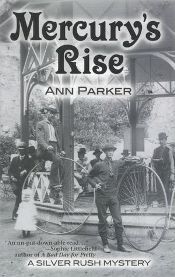 It takes a strong woman to survive in a late 19th-century mining town, serving up drinks and keeping the peace among the customers of her Western saloon. It takes an even stronger woman to hide her independent nature beneath a façade of feminine delicacy when circumstances demand it. In this fourth entry in the Silver Rush mystery series, Inez Stannert proves she's up to the challenge.
It takes a strong woman to survive in a late 19th-century mining town, serving up drinks and keeping the peace among the customers of her Western saloon. It takes an even stronger woman to hide her independent nature beneath a façade of feminine delicacy when circumstances demand it. In this fourth entry in the Silver Rush mystery series, Inez Stannert proves she's up to the challenge.In the summer of 1880, Inez leaves Leadville and the Silver Queen behind to reunite with her two-year-old son, William, who had been living with her sister, Harmony, out East for the sake of his health. While taking a stagecoach ride to their meeting point at the trendy spa town of Manitou, one of Inez's fellow passengers dies a sudden and messy death after drinking his wife's prescription tonic.
Mrs. Pace refuses to believe a heart attack killed her husband, but her concerns are downplayed by the Mountain Springs House's resident doctor and the local marshal. She begs Inez to help her uncover the truth, but in this world of high society elegance, medical quackery, and shady real estate dealings, truth is in even shorter supply than the whiskey Inez craves.
As always, Ann Parker fleshes out her characters and settings beyond the historical mystery subplot. Inez is caught between her desire to help another woman and her complicated family problems. Her long-absent husband, Mark, reappears and worms his way back into her life, to her disgust – and just in time to challenge their divorce. Young William no longer knows her, and while Inez gets reacquainted with her sister and child, Harmony's husband pursues a risky investment. As for where all of this leaves Inez's relationship with her clergyman lover—well, Inez doesn't know either.
This volume will have longtime readers traveling to a new part of Colorado: the Pikes Peak region, which includes the dramatic red rock formations at the Garden of the Gods. But as Inez discovers, ironically so, Manitou is even more of a man's world than rough-and-tumble Leadville was. A murderer may still be at large, but in order to win at this dangerous game, Inez must find a man to play her hand for her.
Between the hotel owners, its medical staff, Inez's busybody aunt, and Inez's charming gambler of a husband, Mercury's Rise has a wealth of strong personalities, ones you won't have met in Western fiction before. Parker retains control of her story, however, and doesn't let them steal the show from Inez. Determined, smart, and brave, she also shows a vulnerable side she won't let herself acknowledge.
The storyline is complex and well detailed, with many moving parts; the scene occasionally loops back to Inez's time in Leadville, so read the chapter headings carefully to see where you are. The natural wonders of the mountain backdrop, the foul-tasting mineral waters, and the many people desperately in search of a tuberculosis cure combine to create a setting that's richly described from many angles. It all makes for an excellent novel that's well worth diving into.
----
Mercury's Rise was published by Poisoned Pen Press in November at $24.95/hardback or $14.95/trade pb ($31.95 or $18.95 in Canada). Thanks to the author, I have a brand new and signed copy available to give away to an interested blog reader. Fill out the form below for your chance to win (open worldwide). Deadline Monday, January 3rd.
<p><p>Loading...</p></p>
Published on December 19, 2011 10:00
December 18, 2011
New review of Diana Gabaldon's The Scottish Prisoner
My review of Diana Gabaldon's The Scottish Prisoner ran in yesterday's Globe and Mail. Here's the link if you'd like to read my take on it. The book's #1 on their hardcover fiction bestseller list, for the second week in a row.
Published on December 18, 2011 08:08
December 17, 2011
Pope Joan TV miniseries premieres tomorrow
 A heads-up that Pope Joan, the film based upon Donna Woolfolk Cross's bestselling historical novel about a legendary woman from Dark Age Germany, will be broadcast as a two-part TV miniseries on the REELZ channel in the US.
A heads-up that Pope Joan, the film based upon Donna Woolfolk Cross's bestselling historical novel about a legendary woman from Dark Age Germany, will be broadcast as a two-part TV miniseries on the REELZ channel in the US.The first showing is on December 18th & 19th at 8-10pm EST; there appears to be a second showing of each episode later on both evenings, starting at 11pm EST. Check with your local TV schedule to confirm!
I'll be watching it for sure. We switched over to satellite TV from cable earlier this year, and we actually get that station.
I've been waiting to see this film for two years. Mark and I were in Germany when it debuted - the photo at left, taken at the Nuremberg train station, was one of many on display throughout the city. However, the film being shown wasn't the original English-language version (added: the one being shown tomorrow and Monday) but one dubbed into German for German audiences. My facility with the language wouldn't have been sufficiently good to follow along, alas.
See more at the REELZ website for the film or the author's home page. If you miss this one, there's an encore presentation on New Year's Eve and New Year's Day.
Published on December 17, 2011 14:10
December 16, 2011
Final shortlist announced for 2011 Langum Prize
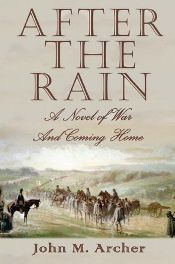 Five historical novels published in 2011 have made the shortlist for this year's David J. Langum Sr. Prize in American Historical Fiction. They are, in alphabetical order by author:
Five historical novels published in 2011 have made the shortlist for this year's David J. Langum Sr. Prize in American Historical Fiction. They are, in alphabetical order by author:1) John M. Archer, After the Rain: A Novel of War and Coming Home (Gettysburg, PA: Ten Roads Publishing, 2011), which takes a psychological perspective on the Civil War, as seen from the viewpoint of a Union army line officer.
2) Geraldine Brooks, Caleb's Crossing (New York: Viking, 2011), set in 1660s Martha's Vineyard and Cambridge, Massachusetts, and centering on the friendship between a minister's daughter and a young man of the Wampanoag tribe. [read my review]
3) Julie Otsuka, The Buddha in the Attic (New York: Knopf, 2011), a short literary novel describing the experiences of Japanese "picture brides" sent to marry Japanese men, mostly farm laborers, working in the US in the early 20th century.
4) Pamela Schoenewaldt, When We Were Strangers: A Novel (New York: HarperCollins, 2011), in which a young seamstress leaves her Italian mountain village to make a new life for herself in 1880s America. [read my review]
5) Susan Vreeland, Clara and Mr. Tiffany (New York: Random House, 2011), about Clara Driscoll, Louis Comfort Tiffany's chief designer at his New York glass studio in the 1890s.
From the press release: "The winner of the 2011 David J. Langum, Sr. Prize in American Historical Fiction will be selected from one of these five books. However, still other books will be discussed in the Director's Mention category. This year the small and often regional presses have issued an unusually large number of high quality books in American historical fiction. Several of these should be discussed and honored, even if only one, After the Rain discussed above, made it onto the formal short list."
For longer descriptions of all five nominees, and for more details on the prize itself, visit the Langum Charitable Trust website. The Trust also welcomes readers' comments on these books on their Facebook page.
Published on December 16, 2011 17:40
December 14, 2011
A voyage up north with Norma MacMillan's The Maquinna Line
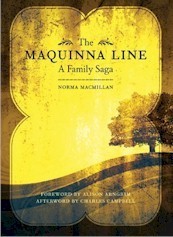 I'm not sure where I first came across The Maquinna Line. It may have been while browsing Amazon.ca, or I could have spotted it on a website dedicated to Hollywood personalities. Norma MacMillan's family saga has an unusual story behind it. Called the author's "lost novel," the manuscript was pulled out of a closet a few years after her death in 2001. Her husband and friends worked to find it a publisher, and it finally appeared in print last year.
I'm not sure where I first came across The Maquinna Line. It may have been while browsing Amazon.ca, or I could have spotted it on a website dedicated to Hollywood personalities. Norma MacMillan's family saga has an unusual story behind it. Called the author's "lost novel," the manuscript was pulled out of a closet a few years after her death in 2001. Her husband and friends worked to find it a publisher, and it finally appeared in print last year.MacMillan, a noted actress in her day, was known for her role as the voice of Casper the Friendly Ghost. Folks from my generation may be more apt to recognize the name of her daughter, Alison Arngrim, famous for playing that nasty wench Nellie Oleson on Little House on the Prairie.
Ms. Arngrim wrote the forward to her mother's book, describing her enthusiasm for writing, the times she left LA on mysterious research trips to the wilds of Nootka Island, and the subject of the book itself, which she found dark, peculiar, and a little disturbing. It wasn't the type of book her mother's upper-crust Vancouver family would have approved of.
Fortunately, the novel stands well on its own without the celebrity association. The Maquinna Line is a classic generational saga in the tradition of James Michener and Edward Rutherfurd. It has a good sense of place and history, though its greatest focus is on its characters and how the social strictures of the time pressure them and determine their choices. Their lives turn out differently than they plan, and their trials and misfortunes make for very entertaining reading.
The main narrative begins in 1910 and continues through the end of WWII, and occasional flashbacks bring us back to earlier periods. Vancouver Island during the Edwardian era offers a mix of cultures, all well represented in the tale. An Icelandic entrepreneur opens a fancy hotel on a private island, promotes it as a tourist attraction, and raises his daughter there. An upwardly mobile couple brings an Indian chief's daughter, a descendant of the 18th-century Chief Maquinna, to live with them as their maid; her cold yet exotic beauty proves irresistible to the area's young men. And an adolescent boy commits a moral transgression he doesn't fully understand, one which destroys the peace in his socially conscious family.
Victoria, British Columbia, at the southern tip of Vancouver Island, is the drama's centerpiece, though it also branches out to include a lumber camp and Moachat village up north as well as other outposts. As the novel implies, the description of the city and its people as Victorian suits them in more than one way (they're called "more English than England").
Norma MacMillan clearly had a passion for the place where she grew up, and she transformed it into a novel I kept wanting to come back to. It packs a lot of story into 276 pages.
The Maquinna Line was published by TouchWood Editions in trade paperback at $19.95 - same price in Canada and the US. For non-Canadians, it's available at a discount on both versions of Amazon, should you so choose.
Published on December 14, 2011 15:00
December 13, 2011
Book review: Chasing the Nightbird, by Krista Russell
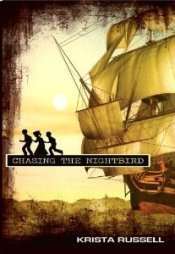 Krista Russell's debut novel is a brisk middle-grade adventure that features an appealingly scrappy hero determined to choose his own path in life.
Krista Russell's debut novel is a brisk middle-grade adventure that features an appealingly scrappy hero determined to choose his own path in life.The Nightbird is the whaling ship where Lucky Valera, an orphan of nearly fourteen, grew up and on which he was looking forward to sailing as a full-fledged crew member. Then the half-brother he never knew existed, Fernando Fortuna, kidnaps him from the New Bedford docks. Since Lucky is under age, Fortuna sets himself up as Lucky's guardian and forces him to toil alongside him at the local mill, claiming Lucky's wages as well as his own.
Amid the brutal pace of the factory, with cotton fibers so thick in the air it's hard to breathe, Lucky befriends a fugitive slave, Daniel. (Given his difficult path to safety, Daniel reveals his personal history to Lucky a little too easily.) Lucky's acquaintance with Emmeline, a Quaker ship captain's daughter, leads to a plan: she'll help him escape on her father's ship if he agrees to help her in the abolitionist movement. This is a challenge he feels he's up to, even though he doesn't trust landlubbers.
Russell achieves a difficult balance, preserving the saltiness of the lingo while keeping the story fairly clean for the intended audience. Lucky's used to being around sailors, and readers will snicker when his mouth gets him into trouble. There is some violence, though it's not out of place for the period or characters.
New Bedford, Massachusetts, in 1851 is a racially mixed society, and Lucky's cultural background adds to the story's complexity. A teenager of Cape Verdean heritage, he loves the Island food served by the boardinghouse landlady. Lucky is a free person of color who doesn't see himself as similar to the former African slaves living in the city, but not everyone views things as he does.
The 1850 Fugitive Slave Act has just passed, amid controversy, and posters on the streets warn fugitives to watch out for bounty hunters. When Lucky realizes the trauma that Daniel faces if he's returned back South, his work toward abolition becomes more than lip service, and his moral journey is handled without it feeling like a lesson.
This book should be a hit for young people and librarians across southeastern New England. There don't appear to be any other historical novels about Cape Verdean Americans available, for one. Its appeal is more than regional, though, as it presents an important slice of American history in an exciting and convincing way.
Chasing the Nightbird was published in June by Peachtree in hardcover ($15.95, 200pp).
Published on December 13, 2011 16:00
December 10, 2011
A look at Leaving Van Gogh, by Carol Wallace
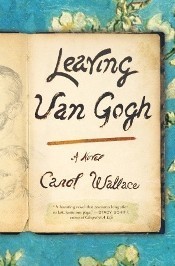 One of the pleasures of writing this blog is having publishers mail me books they think I might enjoy. Carol Wallace's Leaving Van Gogh was one of these; it arrived unexpectedly in my mailbox at work sometime in May. Unfortunately, with my crazy schedule I didn't manage to get to it until now, but I'm glad I finally did.
One of the pleasures of writing this blog is having publishers mail me books they think I might enjoy. Carol Wallace's Leaving Van Gogh was one of these; it arrived unexpectedly in my mailbox at work sometime in May. Unfortunately, with my crazy schedule I didn't manage to get to it until now, but I'm glad I finally did.Leaving Van Gogh fits into that growing category of literary novels that imagine artists' personalities and the background behind the creation of their masterpieces. Dr. Paul Gachet, the physician caring for Vincent van Gogh at the time of his death, reminisces about his professional relationship with his patient and how it grew into a friendship during the seventy days Vincent spent at Auvers-sur-Oise, a small farming town northwest of Paris, in the summer of 1890.
Even if Van Gogh did hijack a narrative that was meant to focus on Dr. Gachet and the provenance of his art collection, as Wallace said in an interview with the Wall Street Journal , Gachet is equally well developed as a character. "I cared deeply about medical problems, but what I wanted to talk about was art," he explains at the beginning. Reasonable, humane, sympathetic, and fascinated by the human mind, Gachet is also an amateur painter who had befriended Cézanne and Pissarro and accepted paintings from them in exchange for medical help. It's through Pissarro that Gachet is introduced to art dealer Theo van Gogh, who asks him to oversee the care of his brilliant but mentally troubled brother, Vincent, who was recently released from an asylum in Provence.
Wallace places us into Gachet's shoes as he observes Vincent, the man and the artist. Van Gogh shows up unceremoniously on Gachet's doorstep, unwashed and ragged and overly thin, and proceeds to transform the quiet lives of Gachet and his two young-adult children with his zest for art. We see Vincent's intensity, the full-body technique with which he applies color to canvas, and the uncanny confidence that lets him believe his work will be remembered a century down the road. This is a wonderful novel to read for those who want to feel involved in the actual process of painting.
At the same time, Vincent remains apart from the people closest to him and seems unaware of the effect he has on them. This includes his devoted brother Theo, whose support of Vincent is draining him financially, as well as Gachet's agreeable daughter, Marguerite, who had never thought of herself as pretty until Vincent paints her at the piano.
It makes for a curious mix, and an irresistible project for Gachet, who starts out sure that the peace of the Auvers countryside, with its chestnut trees and vast wheat fields, is just what Vincent needs to cure him of his malady. He's wrong. Not only is artistic technique in transition at the time, from realism to Impressionism, but medicine sits at a turning point that proves frustrating for its practitioners. Not even experts can cure what they call "hysteria," if that's even what ails Vincent during his raving, near-violent episodes. Gachet doesn't know, and the tragedy is that he is no more able to save Vincent or his brother, an obvious syphilitic, than he could his wife, Blanche, who had died of consumption fifteen years earlier.
Through its interpretations of both Gachet and his patient, Leaving Van Gogh is an affecting portrait of courage in the face of helplessness, one well worth reading for insight into the creative process at its highest and lowest points.
This is the author's first historical novel, and she provides a detailed author's note explaining what was fact vs. invention. Although I didn't realize this when I first picked the book up, I've been reading Carol Wallace's work for some time; she is also the co-author (among other things) of The Official Preppy Handbook, which got passed around my middle school in the early '80s, and To Marry an English Lord, a dishy, informative account of American heiresses' marital successes and foibles in the Gilded Age and Edwardian eras.
Carol Wallace's Leaving Van Gogh was published by Spiegel & Grau (Random House) in April at $25.00 / $28.95 in Canada (hardcover, 268pp).
Published on December 10, 2011 09:00



